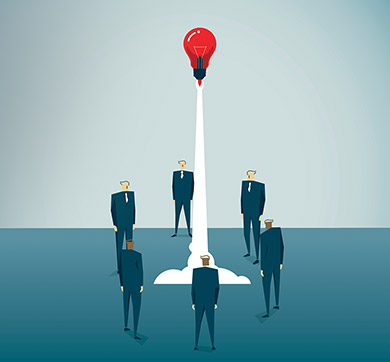December 2020 | 958 words | 4-minute read
Digital design seems to have become the magic bullet that brings customer delight and operational efficiencies to new and existing business ventures.
It therefore begs the obvious question: how?
History of design
To begin with, there is no need to reinvent the wheel, as design is not a new concept. It emerged as a discipline at the beginning of the industrial revolution in the early 18th century. As technology replaced human labour, designers along with engineers developed machines and production flows to execute specific tasks as efficiently as possible. But technology also began to change how people interacted with one another, which created the desire for symbols and icons — brands — that would provide purpose and unite people. One of the most iconic brands of this era was the German electricity company, AEG. In the early 20th century its executive creative director and architect, Peter Behrens, developed what is arguably the first comprehensive design language, defining all aspects of how the brand interacted with the customer.

Over the past 100+ years technology has radically changed with the digital replacing the analogue, but the design mandate remains unchanged. Today data analytics drives the fourth industrial revolution. Our mobile devices keep track of where we are, our online shopping history reveals our preferences, and our social graph informs how we engage with the world around us. The primary task of design is to translate these complex and abstract data workflows into meaningful experiences that are simple and delightful to use. Designers also need to develop brands that are omnipresent across an increasingly fragmented and ever-changing digital ecosystem of myriad screens and platforms. These are not easy tasks!
Approach to design
As the co-founder of Apple Inc, Steve Jobs, said, “Design is not just what it looks like and how it feels. Design is how it works.” The challenge for designers is to find the right tools to communicate their ideas in a way that is clear, engaging and exciting. Everybody who needs to implement the design proposal such as engineering, marketing or operational divisions need to fully understand what is proposed and seek constructive feedback. Design proposals should be simulated and prototyped to be tested with real users before they are rolled out at scale. Any corrections during or after development can be costly, even fatal. The digital economy moves fast. Timing is of the essence.
The most common pitfall in digital design is for the design process to take too long, or development to start before the key elements of the designs are firmed. The process of designing digital experiences is no different from designing physical experiences. For example, architects and digital designers both deal with large projects where many disciplines need to work together to realise something that does not yet exist. A shared vision aligns and enables the team to make it real. The construction of a high-rise does not start before the architect has designed the entire building. Otherwise it would be very likely that the building would turn into a permanent construction site.
"The mission of design therefore is to create a desirable, intelligent and sustainable world."
Similarly, development of digital experiences should not start before everybody is clear of how it will work and look. Digital designers just like architects can avoid mistakes by having a project governance structure that clearly defines each team member’s responsibility, informs each discipline’s workstreams and deliverables, and resolves any interdependencies and de-risks costly delays with a project plan.
Design with a vision
Finally, design with a vision and mission. What differentiates ‘good’ from ‘bad’ design is the ability of the design to make a difference to the customer, employees and business. As the man-made world overtakes the natural one at an increasing speed, it raises the question of how to preserve a world that allows humans to be human. The mission of design therefore is to create a desirable, intelligent and sustainable world.
Designers today integrate environmental and social awareness into physical products. Automotive designers explore alternative power sources for their vehicles while augmenting, assisting and automating driving. Product designers embrace sustainable manufacturing and recycling, to minimise any adverse environmental impact.
However, in the digital world with virtual experiences, awareness of social consciousness is not so evident. While changes in the production process and recycling reduce the overall negative impact on our environment, real change and a reversal of destruction requires a fundamental shift in attitude along with significant behavioural change. That is where digital design can play a great role by becoming the catalyst for change.
A holistic view
As we enter the era of hyper-personalisation, a new approach is needed to go beyond the individual and to consider the whole, the collective and the context of engagement: our environment, society and culture. Universal principles define what kind of world we want to create. They provide the foundation to go beyond the status quo to create something new and better, something unique to a brand and its offering. Another prerequisite is to create consistent experiences across a digital ecosystem that is increasingly fragmented across many different screen sizes and platforms. A contextual design approach coupled with a principle-based design process creates sustainable and efficient solutions in the digital era.
Brands will have to embrace change driven by principles that people can believe in. If they do not, technology can and will create the necessary transparency for caring customers to make the right choice based on what’s good for each one individually and on what’s good for all of us.
Fabian Birgfeld is CEO and co-founder of W12, a TCS Interactive Design Studio. He is a trusted partner in product strategy and service design for global brands.













